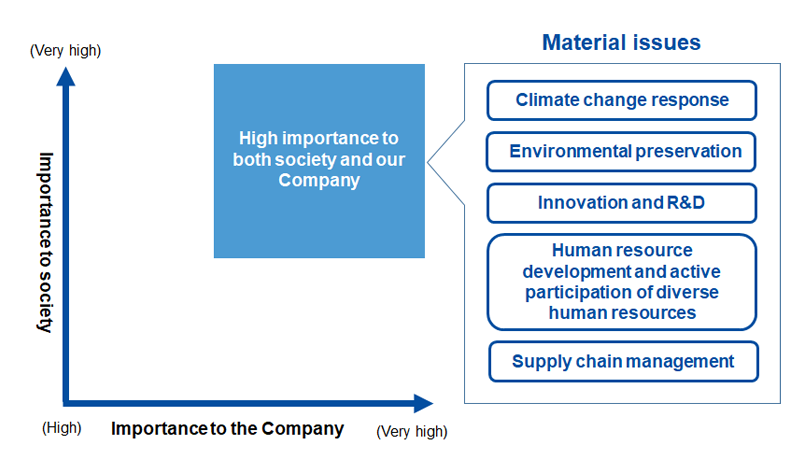Materiality (Priority Issues)
Based on our basic sustainability policy, which states that “We will contribute to the achievement of a sustainable society through our business activities and enhance the prosperity of all stakeholders,” we have identified material issues for the realization of a better society and the growth of our Company, and have set related goals and KPIs.
Process for identifying material issues
Step1: Extraction of potential issues
The secretariat of the Sustainability Committee, chaired by the President, lists potential general (broadly defined) social issues that may be relevant to the Company, based on various sustainability disclosure guidelines, evaluation items of ESG evaluation organizations, and SDGs.
Step2: Materiality assessment and identification
The Sustainability Committee evaluates and maps each potential issue listed in Step 1 on two axes: its importance to the Company and its importance to society. Through discussions at the Committee, material issues are identified, along with basic issues that are prerequisites for business continuity.

Basic issues that are prerequisites for business continuity
Step3: Setting goals and KPIs
The Sustainability Committee and related departments examine and set goals and KPIs for each identified material issue.
Step4: Deliberation and approval
Goals and KPIs are approved after deliberation by the Sustainability Committee and reported to the Board of Directors.
Details of material issues
| Category | Issues and initiatives | Goals and KPIs | Scope of goals and KPIs |
|---|---|---|---|
| Climate change response |
1.Reduction of greenhouse gas emissions |
■Reduction rate of greenhouse gas emissions (Scope 1 and 2; baseline: FY2021)
|
Entire Group |
|
2. Appropriate use of energy |
■Reduction of energy intensity (baseline: FY2021)
|
The Company and its domestic subsidiaries | |
|
3.Contributing to reducing greenhouse gas emissions by customers through products |
■Contribution to reduction of greenhouse gases by expanding supply of high-performance antifoulings (baseline: 2008)
|
Entire Group | |
|
Environmental preservation (including water resources and biodiversity) |
1. Prevention of air and water pollution |
■ Zero environmental incidents (yearly) |
The Company and its domestic subsidiaries |
|
2.Waste management and recycling |
■Waste recycling rate
|
||
|
3.Promoting the development of products with reduced environmental impact |
■Percentage reduction in use of environmental hormones, TX, etc.* (compared to FY2020)
|
Entire Group | |
|
4.Reduction of VOC emissions from products |
■Reduction of VOC emissions by expanding the supply of low-VOC coatings (baseline: 2008)
|
||
|
5. Promotion of biodiversity conservation |
■Increase the sales ratio* of environmentally friendly high-performance antifoulings, which also contributes to measures against transboundary movement of marine organisms
|
||
| Innovation and R&D |
1.Development of innovative products that contribute to global environmental protection |
■Ratio of environmental research themes, including the exploration of sustainable materials and their application to product design
|
Entire Group |
|
2.Development of intellectual property strategies and application to business |
■Number of applications for patent rights related to newly developed technologies (compared to FY2022)
■Introduction of business analysis through the use of IP landscapes and promotion of its use in product development strategies |
||
|
3.Creation of new technologies through open innovation |
■Continue to promote development by collaborating with other companies, universities, and research institutions, exceeding the performance of the previous year, and by effectively utilizing external resources |
||
| Human resource development and active participation of diverse human resources |
1. Employee skill development |
■Rebuild the human resource development system from FY2024 to FY2026 |
The Company |
|
2. Improving employee job satisfaction |
■Sustainably improving employee engagement
|
||
|
3. Promotion of the active participation of women |
■Percentage of female employees among new or mid-career hires
■Rate of taking child-care leave
|
||
| Supply chain management |
1. Establishment of a supplier management system |
■Supplier evaluation rate based on the ESG questionnaire survey (integrated management system using cloud services)
|
Entire Group |
|
2. Promotion of green procurement |
■Percentage of suppliers certified under ISO 14001
|



